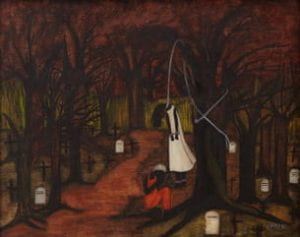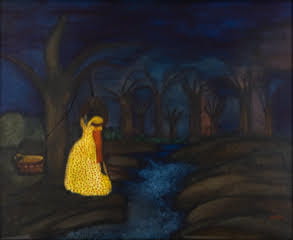Mary Frances Whitfield: Why? is a collaborative exhibition between the Abroms-Engel Institute for the Visual Arts (AEIVA) at the University of Alabama at Birmingham and the Birmingham Civil Rights Institute. The exhibition is co-curated by AEIVA Curator John Fields and Dr. Brandon Wolfe, Assistant VP of Campus and Community Engagement in the Office of the Vice President for Diversity, Equity, and Inclusion at UAB. It is on display at AEIVA until November 23, 2019. The images included below are in the exhibition.
Depictions of lynchings are usually loud – they bring into focus the agony of the victims, their bodies beaten and burned, hanging from a tree, or the intense anger, absolute hatred, and pure evil of the perpetrators and spectators as they relish in their acts of terror, dehumanization and brutality. Mary Frances Whitfield invites us to consider another experience, one that often goes unacknowledged or unconsidered artistically and historically. What happens when the spectacle is over, when the crowd disperses, when the terrorists have gone home, having achieved their fill of racial violence for the day? Who comes to claim the victims, to hold their lifeless bodies one last time, to cut them down and lay them to rest?

watercolor and acrylic on canvas board
16 x 20 inches
photo: Adam Grimshaw
Collection of the artist, Courtesy Phyllis Stigliano Art Projects
©Mary F. Whitfield
Whitfield’s paintings are not loud. They depict a silent despair. She transforms the space of public spectacle, of loud chaos, into a private and still experience that focuses on the quiet mourning of the bereaved. For Whitfield, this mourning conditions the lives of black people in her ancestral history and now. Her depictions are dark and heavy, they are full of grief and despair, and this emotional weight is largely held in the bodies of the mourners who literally hold this anguish – and their faces – in their hands. The victims and the mourners are often dressed in bright pastel colors, an image that foregrounds their vibrancy against the backdrop of a thick and consuming darkness. It reminds us of the life they could have lived, a life that was cut short by hate. Wives wrap their arms around the lifeless bodies of their husbands, young boys reach for the dangling feet of their fathers, women touch their protruding bellies, desperately hoping, we might assume, that their unborn children will not meet the same fate as the victim. Bodies of men, women, children, and babies hang from trees, sometimes engulfed in flames, sometimes appearing to sway slowly in the breeze. The stillness of the victims and the stoicism of the mourners in Whitfield’s paintings reflect the normalcy and the familiarly of an ordinary experience, part of daily existence for African Americans in the 18th and early 19th century, a reality wrought with unbearable pain, constant mourning, and overwhelming fear.

watercolor on canvas board
16 x 20 inches
Collection of the artist, Courtesy Phyllis Stigliano Art Projects
©Mary F. Whitfield
The title of the exhibit invites us to ask “Why?”, and the question looms on several levels. Why lynching? Why Albert? Why Sari-Mae? Why Mama and Papa? Why me? Why us? Why then? And maybe most importantly: Why now?
When the slavebody became the blackbody, white people could not let go of the compulsion to maintain dominance over black bodies and black lives. The vilification and demonization of black people took hold in the discourse, and a consensus grew around the need to protect white people and white dominance, a need so desperate it justified brutal violence and severe oppression against the newly “freed” citizens. Whitfield’s paintings are borne out of stories her grandmother told her about life during this time, a time when more than 4,000 black human beings were lynched publicly and without consequence. The work is timeless, though, and as we leave the exhibit and go out into the world, we are forced to wonder why this is still happening. Lynchings today take a different form, but they continue to terrorize and demoralize black communities all over the United States and emphasize the devaluation of black bodies and black lives in our society.
Toni Morrison says that the purpose and the power of art is in its ability to create conversation, one that is “critical to the understanding of what it means to care deeply and to be human completely.” If we can ask ourselves “Why?”, if we can have this conversation, if we can engage in this discourse honestly and authentically, if we can accept the truth about the continuing legacy of the slave trade and mass enslavement and lynchings in all of its forms – past and present – and then reconcile ourselves to that truth, then maybe through that conversation, we will see a path forward, one that leads us toward healing, one that will someday allow us to live in the peace and freedom and beauty of Dr. King’s dream. It’s a hard question to answer, not in its complexity but in its power to change our understanding of ourselves, but it’s one that we must ask.
